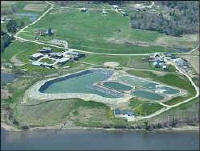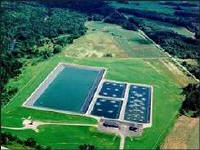Total Suspended Solids
by Tim Loftus
TSS, or
total suspended solids, seems
like an easy and innocent enough test to perform. For the most part, it is. But
are you following this test procedure as it should be followed? Would the way
you perform this test hold up in the legal system? You may get “workable”
results for plant operations, but what about reporting these results to a
regulatory authority? If you do not follow approved methods – exactly – then the
results, even if they are accurate, may not be legally acceptable. These are not
hypothetical situations. I have been through it, and fortunately, my results
were not only accurate, they were performed legally. There was no argument.
Under the Federal NPDES program, you have two approved methods for TSS:
EPA method 160.2 and Standard Methods 2540D. It is important that you read the
methods for the details of the test. But in general, both methods require that
you wash, dry and weigh the glass fiber filters until you achieve a constant
weight. A constant weight shows a variation of less than 0.5 mg or <4% of the
previous weighing. Only then should you use the filter pads for TSS analysis.
Believe it or not, a lot of junk gets washed off the filter pads. If it is not
washed, a positive interference often results. The last thing you need when
measuring TSS on your final effluent is a few extra milligrams that shouldn’t be
there. It can make the difference between meeting your discharge limits or
failing them. Wash and dry the pads for all your NPDES reporting and any other
situations where the results are legally binding.
Sample size is equally important. Say, for instance, that you are running
50 ml of final effluent through the filter in the TSS test. To report the
results in mg/l you must factor the measured TSS mg up by 20 times. In doing so,
you are also factoring any error by at least 20 times. This can be significant
if you have a low TSS limit in your NPDES permit. In this case, it would be
better to use a much larger sample volume.
However, too much sample with high amounts of TSS can be harmful. A
water-entrapping crust can form on the filter pad and will give a positive
interference. This can happen especially with WAS and RAS samples. While these
are not considered “legal” samples, the results do affect plant operation
decisions. Standard Methods recommends that the final weight on the filter pad
be 10 to 200 mg.
Another important aspect of TSS analysis is the filtration apparatus. EPA
method 160.2 requires that all filtration apparatus be fitted with a coarse
(40-60um) fritted disk. Standard Methods requires only a filter apparatus with a
reservoir to have a fritted disk. The fritted disk is a porous glass disk used
to support the filter paper. It helps to provide equal suction under the whole
filter pad. Many of the filtration funnels out there (Gooch, Buchner, membrane
filter funnels) contain perforated disks or bottoms as filter supports.
Realistically, perforated disks typically will perform well, but for many
samples, they will not.
Finally, don’t forget to repeat the drying and cooling of the filter and
sample until a constant weight is achieved.
These TSS method requirements mentioned are often overlooked in many
places. However, it is important to do them. Read the EPA or Standard Methods
test procedures over for the details. Performing the analysis correctly may take
a little more time, but by doing so, your results will be accurate and they will
be legal. And that is why we do lab work. Otherwise, why bother doing it?
If you have any questions, suggestions, or comments, please contact LPC
Chair Paul Fitzgibbons at (401) 222-6780 ext 118 (lab@narrabay.com)
or Tim Loftus at (508) 949-3865. You can also visit our website at newea.org.
Once on the website, press the Lab Practices button.


